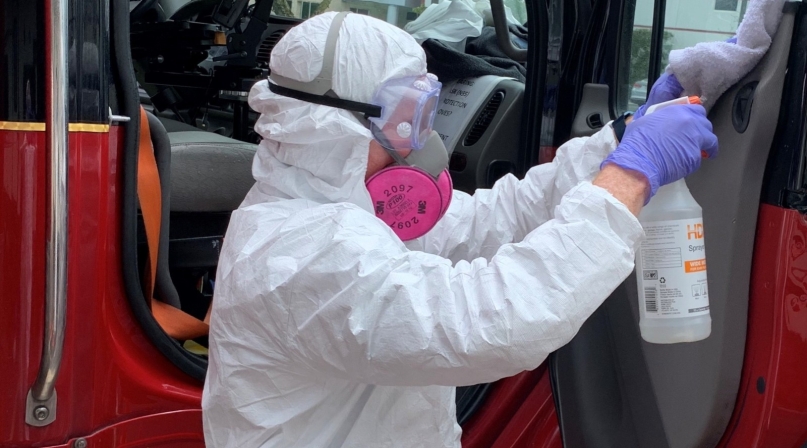County uses decontamination site for EMS vehicles
Author
Upcoming Events
Related News

The last thing on a patient’s mind when being transported in an ambulance is whether it has been disinfected. But for county emergency medical services (EMS) departments, this lands at the top of the list during a global pandemic.
The COVID-19 outbreak brings an array of challenges for efficiently decontaminating transport units to keep county residents safe while ensuring vehicles are available to respond to additional emergency calls.
Calvert County, Md., established a decontamination site for EMS vehicles that takes only 10 to 15 minutes to complete a full disinfection process.
“Early into the pandemic we identified a need to ensure that we could efficiently, quickly and thoroughly decontaminate EMS transport units,” Public Safety Deputy Director Al Jeffery said.
The site aims to reduce the transmission of COVID-19 for first responders by decontaminating ambulances with a disinfectant that meets EPA criteria. After every transport, atomizing foggers, spray bottles and electrostatic sprayers spread the disinfectant throughout the ambulance, on stretchers, door handles, in the driver’s cab area, and all other touch points both inside and outside of a vehicle including steering wheels, seats, carpets, floors and inside the patient care compartment.
“We had one of our fire departments do swab tests after decontamination and it shows it’s 100 percent clean of any COVID-19 virus,” Jeffery said.
Prior to the decontamination site, EMS workers would sanitize vehicles by hand after each transport. They would drop the patient off at the hospital, get back into the possibly contaminated unit wearing personal protective equipment (PPE) and drive back to the firehouse to avoid exposing themselves.
“Imagine driving with their gloves and their gowns and their face masks back to the firehouse,” he said.
When they returned to the firehouse, they would have to decontaminate everything by hand with spray bottles, cloths and an alcohol-based sanitizer.
Jeffery said prior to the new decontamination site, the turnaround time from the hospital to the firehouse which involved de-contaminating the unit, taking off PPE and properly disposing of it, EMS workers decontaminating themselves and then getting the unit back in service would take between two and three hours. The county has an average of 20 EMS calls per day.
“This lets us get that unit back in service in just about two and a half hours sooner so it’s available for immediate service after that,” Jeffery said.
The site is located next to the CalvertHealth Medical Center near the emergency department entrance and is open 24/7. There is a tent for decontamination gear with trash receptables for hazardous materials where crews can drop off equipment. A 25-foot camper houses staff during shifts and there are areas for crews to remove personal protective equipment and wait for vehicles to be sterilized.
The Department of Public Safety contracted with Pristine Inc., a Maryland-based company, to provide the decontamination service and has worked with CalvertHealth Medical Center to set up the site. The site has also been used for other county vehicles including police, fire, parks and recreation and department of public works.
“It’s any vehicle where a COVID-positive employee or patient might have gotten into the vehicle so we can ensure that that vehicle is decontaminated so we can continue to use it,” Jeffery said.
He emphasized the difference between cleaning and disinfecting units.
“This is a decontamination process to kill any residual COVID-19 virus in the unit,” he said. “Cleaning is a separate issue that the department still handles.”
For other counties looking to establish decontamination sites, Jeffery advises getting multiple quotes from companies.
“The cost of this contract wasn’t built in anybody’s budget so we’re identifying budgetary money to pay for this,” he said.
Looking for a long-term solution, Jeffery sees decontamination units being built into all firehouses throughout the county.
“My planning section and logistics section will come up with a plan on how we can accomplish this type of decontamination in the firehouse,” he said. “There’s ways to do that — put in new gear and a type of decontamination equipment so when they get back, they can decontaminate their unit there.”
While this may take longer than 15 to 20 minutes, Jeffery said it would cut down on the cost and create a permanent solution to ensure units are disinfected.
“It would ensure our units are decontaminated, ready for use and safe for not just the public to use, but our first responders to use,” he said.

Attachments
Related News

County officials moonlight in search and rescue roles
For some county officials, participating in search and rescue operations is another way to serve their communities, and make it safer for people to enjoy natural recreation resources.

SUPPORT Reauthorization Act of 2025: What it means for counties
On December 1, the bipartisan SUPPORT for Patients and Communities (SUPPORT) Reauthorization Act of 2025 (H.R. 2483) was signed into law. The reauthorization renews vital federal funding for programs that seek to prevent opioid overdoses and expand treatment and recovery options.

DHS releases FY 2026 funding opportunities for World Cup and Counter-UAS grants
The U.S. Department of Homeland Security (DHS) and the Federal Emergency Management Agency (FEMA) have released the FY 2026 Notices of Funding Opportunity (NOFOs) for two major new homeland security grant programs: the FIFA World Cup Grant Program and the Counter-Unmanned Aircraft Systems (C-UAS) Grant Program.
